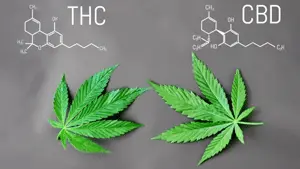Adolescence. What a strange and wonderful time. When they can build magnificent worlds in Minecraft, but when asked to change the bin bag, they hold it like a wet cloth in one hand while staring at you with the look of "how do I open this?" This trend persists from age 10 to age 19 (and some would argue even up to age 24). But this piece is not about the mysteries of the teenage brain, but rather what does cannabis do to the adolescent brain? Let us learn the science behind youth cannabis use, mental health, and responsible use strategies supported by research.
With cannabis becoming more accessible across the globe, including in South Africa, this question of how cannabis use affects youth health is more relevant than ever. Whether you are a teen, parent, educator, or healthcare provider, understanding the effects of cannabis on adolescent brain development and mental health is crucial.
Here we break down what science says about teen cannabis use, separating myths from facts, and provide evidence-based tips for safer, more responsible cannabis use.
The Adolescent Brain and Cannabis: A Critical Connection
One of the most searched questions today is: "How does cannabis affect the teenage brain?"
Research published in Nature Reviews Neuroscience shows that the adolescent brain is still developing until around age 25. During this period, regions such as the prefrontal cortex, which govern judgment, impulse control, and memory, are particularly sensitive.
Cannabis interacts with the endocannabinoid system, which plays a role in regulating these functions. Heavy, frequent cannabis use during this phase can disrupt development and potentially lead to long-term cognitive effects.
A landmark study from JAMA Psychiatry found that people who began using cannabis regularly before age 18 showed an average IQ decline of 6 to 8 points over time, particularly with persistent use.
Cannabis and Mental Health in Teens: Risk or Relief?
Is Cannabis bad for your mental health? The answer depends on how much, how often, and at what age it is used. While cannabis is being explored as a treatment for anxiety, PTSD, and depression, early and high-THC cannabis use in adolescents is associated with a higher risk of:
- Anxiety and panic attacks
- Depression
- Psychosis or schizophrenia (especially in those genetically predisposed to this condition)
In a 2019 study published in The Lancet Psychiatry, researchers found that daily cannabis use, especially high-THC strains, can increase the risk of developing psychotic disorders by up to five times.
Not All Cannabis Is The Same: THC vs CBD in Youth Use
A major mistake people make is assuming all cannabis is the same. It is not. Cannabis plants contain over 100 cannabinoids, but the two most studied are:
- THC (tetrahydrocannabinol) – the compound responsible for the psychoactive "high"
- CBD (cannabidiol) – a non-intoxicating compound that may reduce anxiety and balance out THC's effects

New research suggests that cannabis products with higher CBD-to-THC ratios may reduce the risk of psychosis and cognitive issues. That is a key takeaway for harm reduction among youth experimenting with cannabis.
Harm Reduction for Youth: Responsible Cannabis Use
Telling young people to "just say no" does not work. Instead, science supports a harm reduction approach to cannabis education for youth.
Lower-Risk Cannabis Use Guidelines for Teens (Adapted from the Canadian Centre on Substance Use and Addiction)
- Delay cannabis use as long as possible (ideally, only start using after age 21)
- Avoid daily or frequent use to reduce long-term risks
- Choose lower-THC strains, but rather higher-CBD strains
- Don't use cannabis if there is a personal or family history of mental illness
- Never mix cannabis with alcohol or other drugs
- Avoid smoking – use vaporisers or oils for safer consumption
Medical Cannabis for Youth: A Different Discussion
While recreational use among teens comes with risks, medical cannabis under professional supervision can be beneficial for certain youth conditions, including:
- Drug-resistant epilepsy
- Autism spectrum disorders
- Severe anxiety or PTSD
The World Health Organisation (WHO) has concluded that CBD is generally safe and non-addictive, even for children in medical contexts. But it is crucial to differentiate between recreational cannabis and medical-grade, doctor-supervised treatments.
Conclusion
We have empowerment through honest, science-based education, and it shows that youth cannabis use is a complex issue. But the solution is not fear, it is information, responsibility, and access to support. By teaching young people about the science behind cannabis, we empower them to make informed decisions. This means:
- Understanding how cannabis affects developing brains
- Being aware of mental health risks linked to high-THC cannabis
- Practising safe and responsible cannabis use when they choose to engage
In a world where cannabis is more accessible than ever, evidence-based education is the best tool we have to protect youth health and well-being.
References
- Giedd, J.N. (2008). The teenbrain: Insights from neuroimaging. Nature Reviews Neuroscience
- Meier, M.H. et al. (2016). Persistent cannabis users show neuropsychological decline. JAMA Psychiatry
- Di Forti, M. et al. (2019). Contribution of cannabis use to psychotic disorders. The Lancet Psychiatry
- Englund, A. et al. (2013). CBD inhibits THC-elicited paranoid symptoms. J Psychoparmacology
- CCSA. (2017). Lower-Risk Cannabis Use Guidelines
- WHO. (2018). Cannabidiol (CBD) Review Report
Disclaimer: This blog supports responsible cannabis use. The information contained in this article is for educational and informational purposes only and is not intended as health or medical advice. Always consult a physician or other qualified health provider regarding any questions you may have about a medical condition or health objectives.
Youth Health and Cannabis